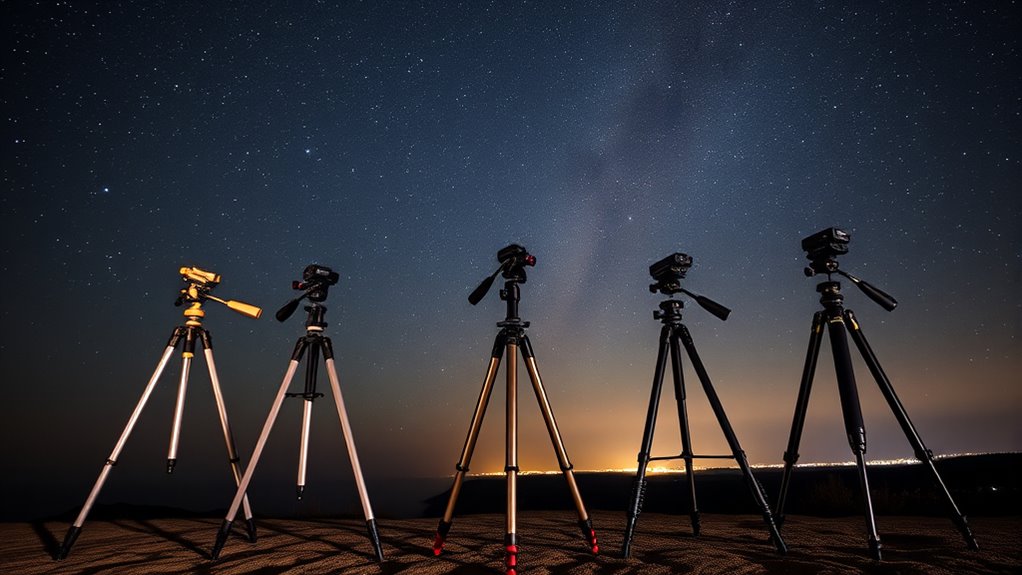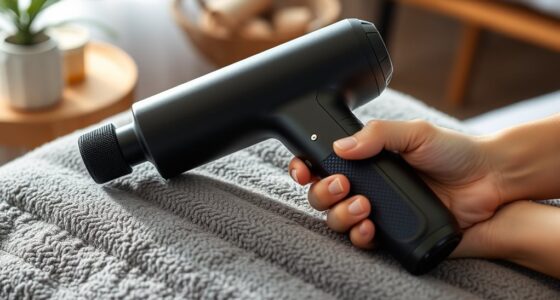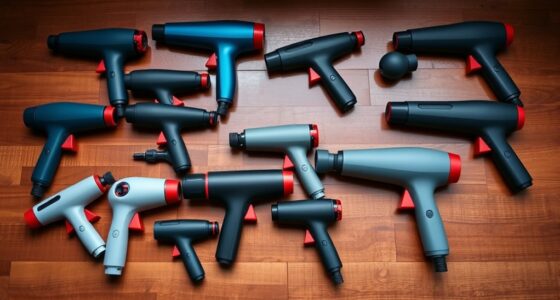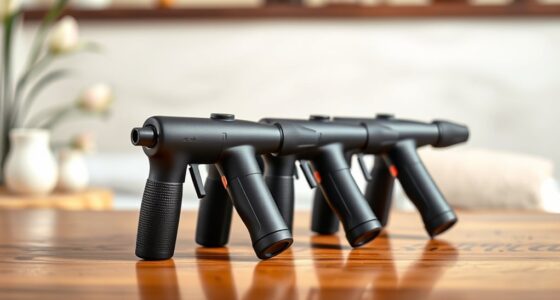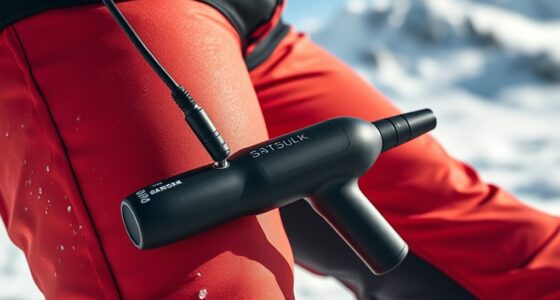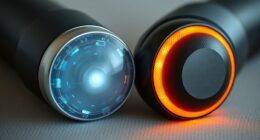If you want to capture stunning astrophotos in 2025, I recommend choosing a stable, lightweight tripod or pier mount with precise controls. The Vortex Optics Mountain Pass Tripod Kit and Sky-Watcher AZ-GTI GoTo Mount are great options for stability and portability, while the iOptron SkyHunter offers height flexibility. For serious tracking, the iEXOS-100-2 system is excellent. Keep reading to discover detailed features that will help you pick the perfect setup for your night sky adventures.
Key Takeaways
- Prioritize stability features like independent leg locks, vibration dampening, and low center of gravity for sharp astrophotos.
- Choose lightweight, portable mounts that balance stability with ease of transport for remote outdoor shooting.
- Ensure adjustable height ranges with telescoping legs or extension shafts to optimize viewing angles and setup flexibility.
- Verify compatibility with your existing astrophotography equipment, including mounting threads, dovetails, and accessory support.
- Opt for durable materials such as machined aluminum or stainless steel to withstand outdoor conditions and ensure longevity.
Vortex Optics Mountain Pass Tripod Kit
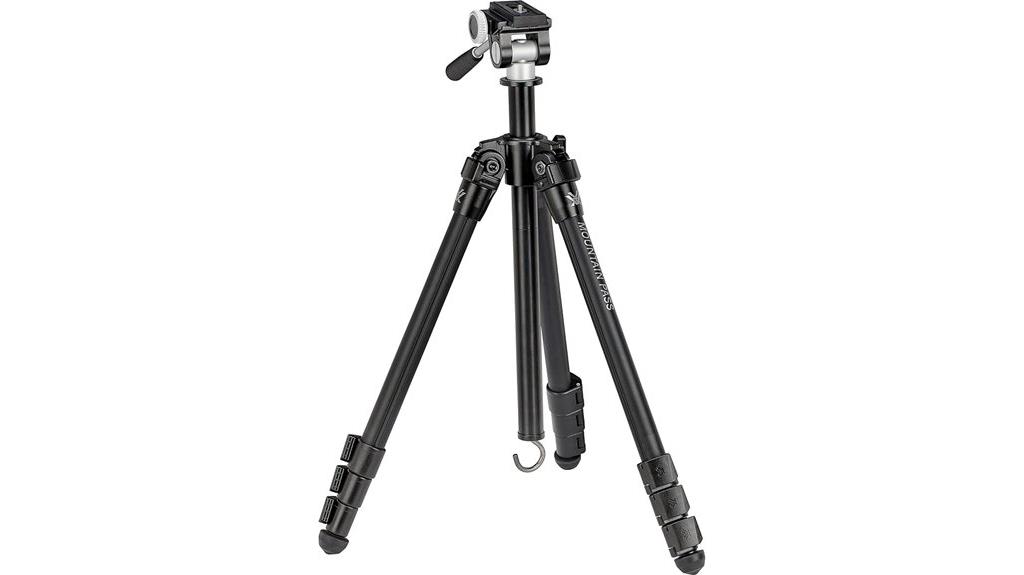
If you’re looking for a reliable tripod that combines portability with sturdy support, the Vortex Optics Mountain Pass Tripod Kit is an excellent choice for astrophotography enthusiasts. Made from machined aluminum, it’s lightweight yet durable, supporting up to 22 pounds—perfect for larger binoculars and spotting scopes. Its two-way pan and tilt head is compatible with Arca-Swiss quick-release plates, making adjustments effortless. The telescoping legs lock quickly with flip levers, ensuring stable, smooth movement. At just 3.6 pounds, it’s easy to carry into remote locations. Overall, it offers a solid, versatile platform to capture sharp, steady images of the night sky.
Best For: outdoor enthusiasts, wildlife watchers, and astrophotographers seeking a lightweight, durable tripod for stable imaging and observation.
Pros:
- Made from machined aluminum for a durable yet lightweight design
- Supports up to 22 pounds, suitable for larger optical devices
- Two-way pan and tilt head with Arca-Swiss compatibility for easy adjustments
Cons:
- Weighs 3.6 pounds, which may be slightly heavier for ultra-light backpacking
- Limited to a maximum load of 22 pounds, not ideal for very heavy equipment
- Smaller size may not provide the extended height some users require
NEEWER Basic 74″ Video Tripod Monopod
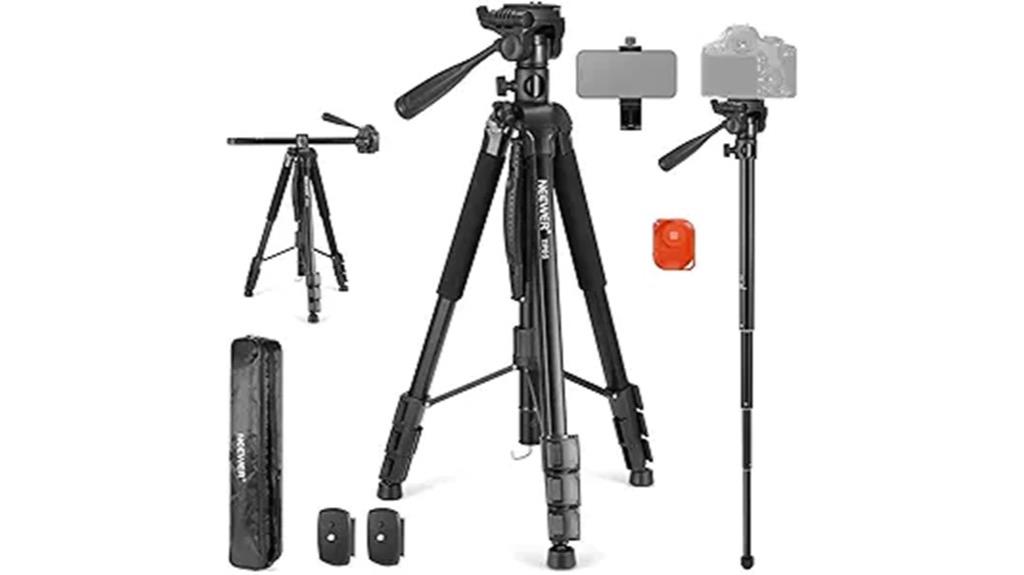
The NEEWER Basic 74″ Video Tripod Monopod is an excellent choice for astrophotographers who need a versatile, portable support that can handle both wide-angle shots and overhead perspectives. Made from durable aluminum alloy, it supports cameras and smartphones up to 17.6lb and weighs just 3.9lb, making it easy to carry. Its adjustable height ranges from 23.6″ to 74.4″, and the 3-way pan head allows smooth adjustments. You can switch between tripod and monopod modes quickly, perfect for dynamic setups. The included Bluetooth remote and phone holder boost convenience for capturing starry skies, time-lapses, or vlogging under the stars.
Best For: amateur and professional photographers, videographers, and astrophotographers seeking a versatile, portable tripod and monopod solution for various shooting environments.
Pros:
- Supports equipment up to 17.6lb (8kg), suitable for a wide range of cameras and smartphones
- Lightweight and foldable design (3.9lb), making it easy to transport and set up on the go
- 3-way pan tilt head with smooth adjustments and detachable monopod function for versatile shooting angles
Cons:
- The maximum height of 74.4 inches may be limiting for very tall shooting scenarios
- Basic features without advanced stabilization or motorized controls may not satisfy professional needs
- The Bluetooth remote’s range (≤33ft/10m) could be restrictive in some situations
Sky-Watcher AZ-GTI Portable GoTo Mount
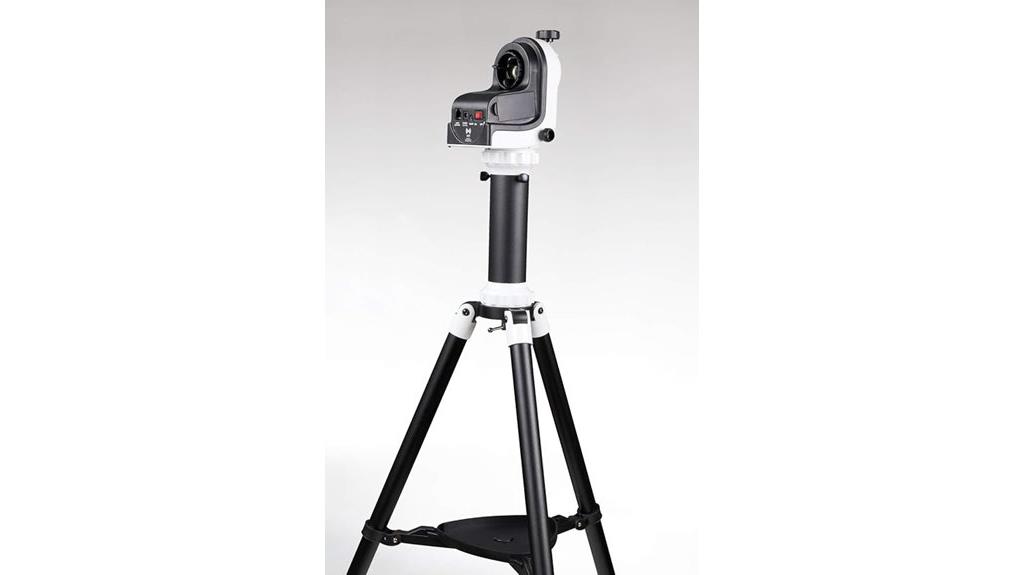
Designed with portability and ease of use in mind, the Sky-Watcher AZ-GTI Portable GoTo Mount is perfect for astrophotographers who want to take their gear on the go. Weighing just 8.6 pounds, it supports up to 11 pounds of equipment and features an adjustable aluminum tripod with a pier extension, ranging from 28 to 53 inches. Its durable brass and aluminum gears ensure smooth, precise tracking, ideal for observing or imaging. With built-in WiFi and compatibility with the SynScan Pro app, you can control it via smartphone or tablet. Whether for planetary, lunar, or deep-sky imaging, this mount offers flexibility and reliability in a compact, travel-friendly package.
Best For: amateur astronomers and astrophotographers seeking a portable, easy-to-use mount for celestial observing and imaging on the go.
Pros:
- Lightweight and compact at only 8.6 pounds, making it highly portable for travel.
- Supports up to 11 pounds of equipment, suitable for small telescopes and DSLR cameras.
- Built-in WiFi and app control via SynScan Pro for easy, smartphone-based operation and precise tracking.
Cons:
- Limited payload capacity may restrict larger or heavier telescopes and accessories.
- Slightly higher price point compared to basic manual mounts.
- Compatibility with only small to medium-sized gear might limit use for advanced or heavy-duty astrophotography.
iOptron SkyHunter Extension Pier and Tripod
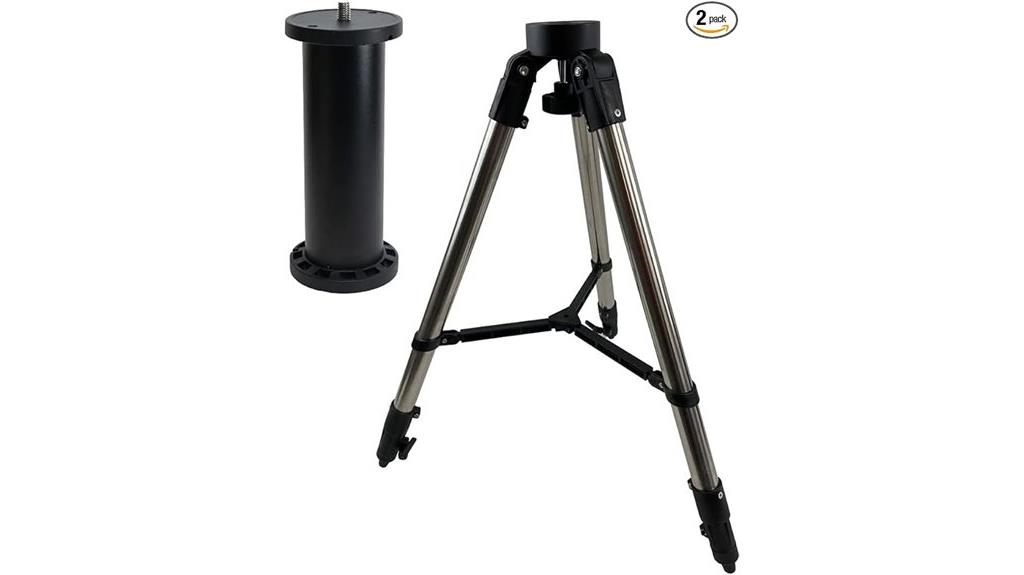
For astrophotographers seeking stability and versatility, the iOptron SkyHunter Extension Pier and Tripod offers an excellent solution. It includes a sturdy 1.25-inch stainless steel tripod and a 7.5-inch aluminum extension pier, designed for compatibility with SkyHunter and other mounts with 3/8-16 threads. Weighing 24 pounds, it provides a solid foundation for precise astrophotography. The extension pier’s flange diameter is 82mm, with a tube diameter of 58mm, offering flexible mounting options with 3/8-16 or 2X M6 holes. Rated 4.7 stars, it’s a reliable choice for those wanting enhanced stability during night sky captures.
Best For: astrophotographers seeking a stable and versatile platform for night sky imaging and mount support.
Pros:
- Durable construction with stainless steel tripod and aluminum extension pier for stability and longevity.
- Compatible with multiple mounts and cameras featuring standard 3/8-16 threads, offering flexibility.
- Provides an additional 7.5 inches of height to improve viewing angles and capture options.
Cons:
- Heavier weight of 24 pounds may require more effort to transport and set up.
- Limited to mounts with 3/8-16 or M6 mounting options; not compatible with all tripod types.
- Price may be higher compared to simpler or smaller tripod solutions for casual users.
iEXOS-100-2 PMC-Eight Astrophotography Tracker System (WiFi & Bluetooth Compatible)
If you’re serious about astrophotography and want precise tracking, the iEXOS-100-2 PMC-Eight system is an excellent choice because it offers WiFi and Bluetooth connectivity that simplify setup and control. Its integration of eight independent CPUs ensures fast, reliable responsiveness, making alignment and star navigation easier. The system features quiet stepper motor belt drives with dual-axis worm gears, providing smooth, accurate movement. The intuitive ExploreStars app, compatible with Apple, Android, and Windows tablets, allows quick polar alignment and celestial object tracking. Weighing just 20 pounds, it’s portable yet robust, making it a versatile addition to any astrophotographer’s gear collection.
Best For: serious astrophotographers seeking precise, reliable tracking with advanced connectivity features for easy setup and star navigation.
Pros:
- Integrates eight independent CPUs for fast, responsive operation
- Quiet stepper motor belt drives with dual-axis worm gears ensure smooth, accurate movement
- Compatible with the intuitive ExploreStars app on multiple platforms for quick alignment and celestial tracking
Cons:
- Relatively heavy at 20 pounds, which may affect portability for some users
- Higher price point compared to basic tracking systems
- Requires a compatible device with WiFi or Bluetooth for full functionality
Factors to Consider When Choosing Tripods and Pier Mounts for Astrophotography
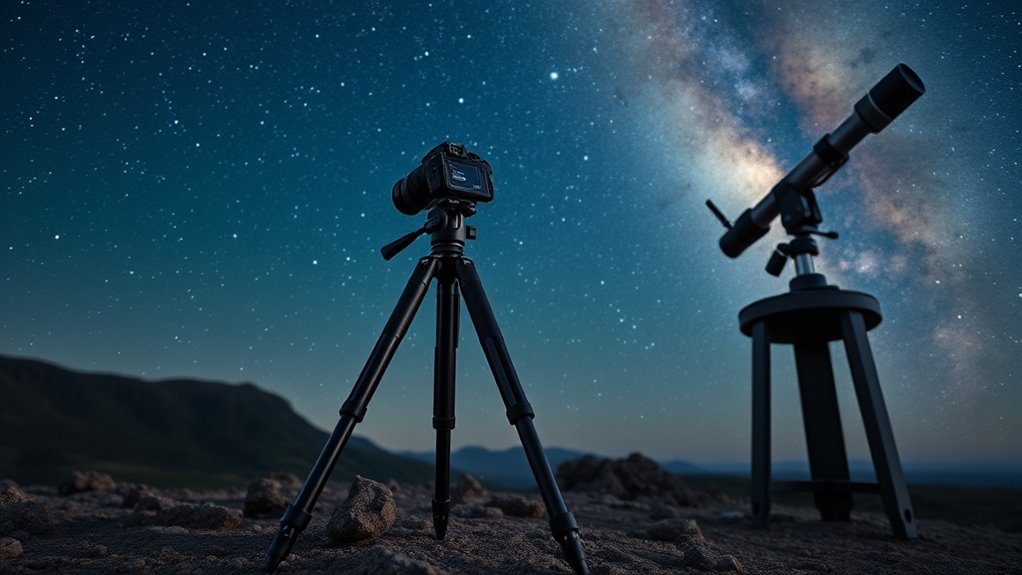
When selecting a tripod or pier mount for astrophotography, I focus on stability and vibration control to ensure sharp images. I also consider weight and portability so I can easily carry and set up my gear, along with height adjustability to match different observation angles. Ultimately, I check compatibility with my equipment and the durability of the build material to guarantee long-term reliability.
Stability and Vibration Control
A stable tripod or pier is crucial for capturing sharp astrophotos, and selecting one with a rigid structure is essential. Materials like machined aluminum or stainless steel reduce flexing and vibrations, ensuring a firm foundation. Adjustable, independent leg locks and quick-release mechanisms help create a secure setup that resists movement during long exposures. Vibration damping features, such as rubber feet or isolation pads, absorb external shocks and minimize residual vibrations. The center of gravity should be low and well-centered to improve stability and prevent tipping, especially with heavier telescopes or cameras mounted. Additionally, a mount with smooth, precise movement controls and minimal backlash helps maintain stability during tracking and framing adjustments. Prioritizing these factors ensures sharper, clearer astrophotos with less post-processing needed.
Weight and Portability
Choosing a tripod or pier mount that balances stability with portability can make or break your astrophotography sessions. Lighter options, typically weighing between 3 to 10 pounds, are much easier to carry, especially when shooting in remote or outdoor locations. These portable mounts are designed to be lightweight without sacrificing too much stability, making setup quicker and less tiring. Heavier mounts tend to offer better stability, but they can be cumbersome to transport and set up in the field. It’s essential that the weight capacity matches or exceeds your equipment’s weight to ensure safe, steady operation. Foldable or collapsible designs further enhance portability, allowing you to pack your gear efficiently while still maintaining the structural integrity needed for clear, sharp images at night.
Height Adjustability Range
Have you ever struggled to find the right height for comfortable astrophotography sessions? That’s where the height adjustability range of your tripod or pier mount becomes essential. A wider range allows you to easily switch between standing and seated positions, accommodating different user heights and observing angles. Precise height adjustments are critical for aligning your equipment with celestial objects at various altitudes, ensuring stability and comfort. Most tripods and mounts achieve this flexibility through telescoping legs or extension sections, giving you the ability to fine-tune the height as needed. Balancing portability with a sufficient adjustment range is key—too tall or too short can hinder your setup. Ultimately, a good height range helps you optimize your view and capture the night sky with ease.
Compatibility With Equipment
Ensuring your tripod or pier mount is compatible with your astrophotography equipment is crucial for a stable and effective setup. First, check that the mounting threads match your gear, such as 3/8-16 or M6, to guarantee proper attachment. Verify the weight capacity exceeds your telescope and accessories’ combined weight, preventing instability. It’s also essential to confirm that the mounting platform supports your telescope’s dovetail or mounting plate system. Additionally, consider whether the height adjustments and stability features suit your preferred observation or imaging angles. Ultimately, ensure your tripod or pier can handle extra accessories like counterweights, guiding scopes, or cameras if needed. Compatibility guarantees a secure setup, minimizing vibrations and maximizing your astrophotography success.
Build Material Durability
Since outdoor conditions can be harsh, the durability of tripod and pier mount materials is critical for reliable astrophotography sessions. Materials like machined aluminum are popular because they combine high strength with a lightweight design, and they’re resistant to corrosion, which extends their lifespan. Stainless steel offers exceptional durability and stability, especially in tough environments, but it tends to be heavier. The quality of construction—welds, fittings, and joints—also impacts longevity and resistance to wear or mechanical failure. Additionally, applying corrosion-resistant coatings or anodized finishes can markedly boost a material’s resilience against moisture, temperature fluctuations, and wind. Choosing robust, weather-resistant materials ensures your equipment withstands the elements, maintaining stability and performance during those long night sessions.
Ease of Setup
Choosing the right tripod or pier mount for astrophotography starts with ease of setup. I look for models with quick-release mechanisms or flip levers that let me assemble everything quickly without tools. Clear, labeled leg locks or clamps are essential—they make adjusting height and angles simple and fast. I also prefer equipment with intuitive leveling features, like bubble levels or built-in spirit levels, to get my setup right immediately. Lightweight designs with compact folding capabilities help me transport gear easily and cut down on setup time. Lastly, smooth, responsive joints and hardware ensure precise positioning with minimal effort. A setup that’s straightforward and quick lets me spend more time capturing the night sky and less time fiddling with gear.
Weather Resistance Features
When selecting a tripod or pier mount for astrophotography, weather resistance should be a top priority. Look for models with weatherproof coatings like powder-coated aluminum or stainless steel, which resist corrosion from rain and humidity. Sealed joints and weather-resistant gaskets are essential to prevent water from damaging internal parts. Choose equipment with UV-resistant finishes to withstand prolonged sun exposure without fading. Check the manufacturer’s temperature range specifications to ensure reliable performance in extreme cold or heat. Additionally, opt for designs with quick-drying features or drain holes, which help moisture escape and promote rapid drying after exposure to rain or dew. These features help protect your gear, ensuring consistent performance and longevity during your night sky adventures.
Price and Budget Balance
Finding the right balance between price and features is essential when selecting a tripod or pier mount for astrophotography. You want reliability without overspending, so consider what’s truly necessary. Budget options might lack advanced stability or high load capacity, which can impact long-exposure shots. Investing in higher-priced models typically offers better build quality, durability, and vibration dampening, resulting in sharper images. Think about how often you’ll use the equipment; occasional astrophotographers might opt for more affordable options, while frequent users will benefit from premium gear that performs consistently. Comparing the price-to-performance ratio helps identify models that meet your needs without breaking the bank. Striking this balance ensures you get the best value and quality for capturing stunning night sky images.
Frequently Asked Questions
How Do Weather Conditions Affect Astrophotography Tripod Stability?
Weather conditions can really impact my astrophotography tripod stability. Strong winds shake the tripod, making it hard to get sharp images, while rain or moisture can cause slipping or rust over time. Cold temperatures can stiffen joints, reducing stability, and uneven ground can lead to tilting. I always check the forecast, secure my tripod well, and choose stable, flat surfaces to minimize weather-related issues.
What Are the Maintenance Tips for Prolonging Tripod Lifespan?
To extend my tripod’s lifespan, I regularly clean it after each session, especially if I’ve used it in dusty or humid conditions. I lubricate the moving parts sparingly to prevent rust and keep the locks tight but not over-tightened. I store it in a cool, dry place, and I check for any signs of wear or damage before each use. Proper maintenance keeps it steady and reliable for years to come.
Can Tripods Support Heavy Camera and Lens Setups Effectively?
Yes, tripods can support heavy camera and lens setups if you choose a sturdy, well-built model. Don’t put all your eggs in one basket—look for tripods with high load capacities and robust materials like carbon fiber or aluminum. I’ve found that investing in a quality tripod guarantees stability, especially during long exposures. Remember, a solid foundation is key when chasing those perfect astrophotos, so pick wisely!
Are There Specific Tripod Features for Handheld Astrophotography?
Yes, there are specific tripod features for handheld astrophotography. I look for lightweight, portable tripods with sturdy build quality, quick-release plates, and smooth, precise pan and tilt movements. A ball head with locking mechanisms helps stabilize my camera during long exposures, while adjustable legs offer flexibility on uneven terrain. These features make it easier to capture sharp, clear shots of the night sky without adding bulk or complexity to my gear.
How Do Vibration Reduction Features Improve Astrophotography Results?
Vibration reduction acts like a calming spell, soothing the restless energy of shaky hands and trembling mounts. It stabilizes your camera, allowing stars to shine in crisp, clear detail. Without it, even tiny tremors blur your images, turning celestial wonders into smudged illusions. With VR, your astrophotography becomes a steady voyage through the night sky, revealing intricate details that would otherwise be lost in the dance of movement.
Conclusion
Choosing the right tripod or pier mount can truly elevate your astrophotography game. I remember a friend struggling with shaky shots until he switched to a dedicated astrophotography tracker—his night sky images went from blurry to stunning. Whether you’re just starting out or upgrading your gear, investing in quality equipment makes a difference. Trust me, capturing crisp, detailed shots of the stars is worth the effort—and the right gear makes it all possible.
